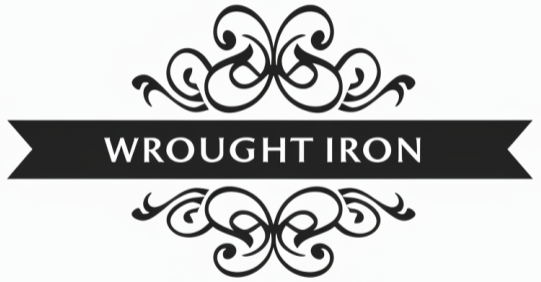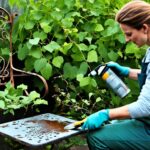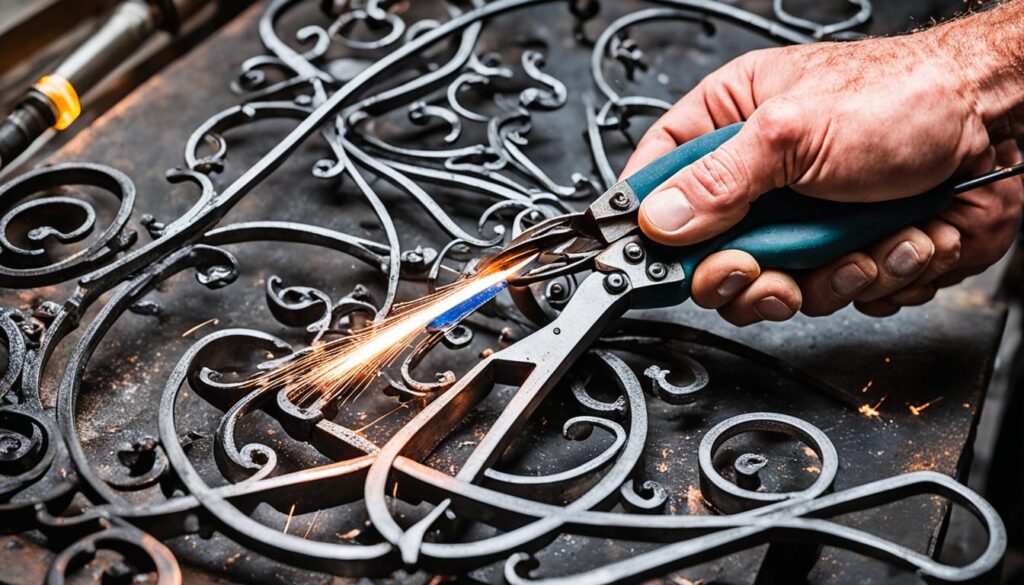
Is it possible to fix wrought iron without welding tools? We’ll explore a mix of old and new ways for a breakthrough in DIY repair. Thanks to the latest in chemical bonding and manufacturing, we have better options. These new methods avoid the downsides of welding, offering strength and convenience instead.
Key Takeaways
- Modern chemistry offers alternatives to welding for non-structural repairs.
- Two-part epoxy adhesives provide a strong and flexible bond for metals1.
- Repairing wrought iron without welding can result in a rustproof seam.
- This guide offers a simple, user-friendly approach.
- You can achieve professional results with common tools and materials.
- Emphasizing the ease and practicality of no weld wrought iron repair techniques.
Understanding Wrought Iron and Its Characteristics
Wrought iron stands out because of its special features, setting it apart from other types of iron.
What Makes Wrought Iron Unique?
One key wrought iron characteristic is its twisted, fibrous look. This comes from being heated and shaped by hand. It makes wrought iron flexible and hardy, less likely to rust than mild steel2. Also, this durable wrought iron holds up well in many weather conditions.
In Scotland, many buildings from the late 1700s and early 1800s used cast iron. Even then, wrought iron was preferred for its workability. Its ability to be shaped by hand made it the choice for many projects2.
By the 1800s, Scotland was a big exporter of cast iron goods thanks to their durability. But, wrought iron was still seen as superior because of its making process. Cast iron was more common due to Scotland’s ore. Yet, good quality wrought iron’s scarcity made it valued2.
Common Issues with Wrought Iron
Wrought iron can face problems over time, even with its strength. It will rust when it meets water and air, turning into its natural, rusty form2. This may lead to issues like rust spots on painted iron or stains on stone below2.
To keep it looking good, a fresh coat of paint is needed every few years. These steps help avoid costly fixes and keep it pretty3.
For fixing, choose repairs without welding to avoid weakening the iron2. This keeps the structure strong. Skilled workers who understand old iron should handle such tasks3. Their work keeps the iron’s classic look and function.
Assessing the Damage to Your Wrought Iron
Before starting any repairs, always do a careful wrought iron damage assessment. This check-up tells you what’s wrong and how bad it is. It guides you on the best fixes.
Visual Inspection Steps
Start with a good look at the iron. Check for rust, bends, or breaks. These are common signs of trouble4. Also, watch out for flaking paint and plants growing on the iron. These can both damage it4.
Types of Damage to Look For
Wrought iron can face many issues. For instance, it might rust from coming in contact with other metals4. Things like being hit or have stones pushed against it could also cause damage. This can lead to bending or breaking, which is bad for the iron4.
It’s important to spot these problems early. This way, your repair work will be top-notch and really help. Keeping an eye on your iron over time can make it last for years, even over a hundred years with the right care5.
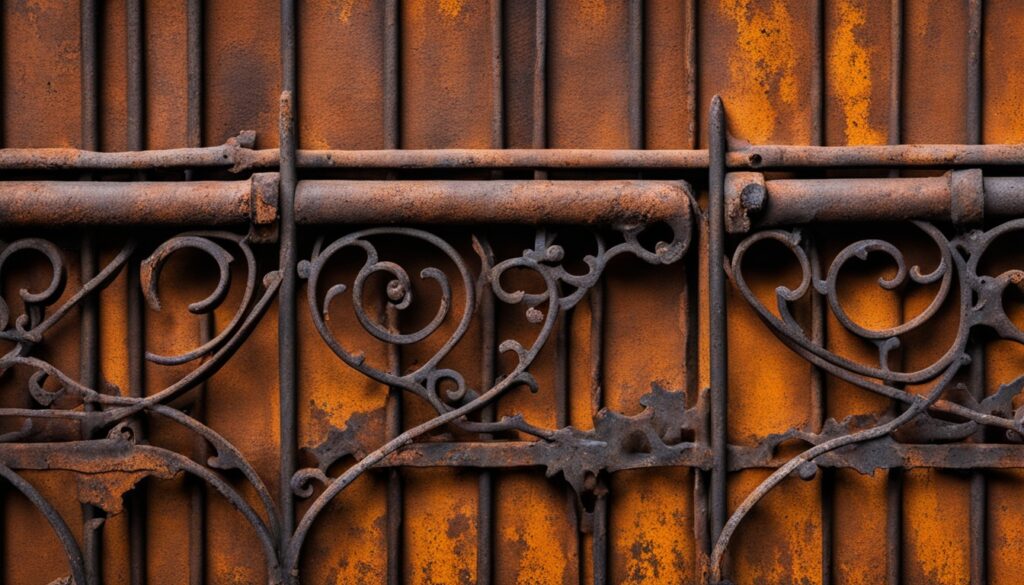
How to Repair Wrought Iron Without Welding
When you need to fix wrought iron without welding, there are several ways to do it. Using strong glues like Belzona, Loctite, and Devcon can achieve great results. These glues work well when welding isn’t an option or could cause more harm. Picking the right glue is key. It depends on what the iron part will face, so it keeps everything together well6.
Using bolts and screws is also a good way to repair wrought iron. First, drill holes carefully, then use bolts to connect the broken parts. This method is strong, which is perfect for fixing big structures that need extra hold. Sometimes, metal brackets are added to make the fix even tougher6. It’s a simple method, which many DIY fans and pros like to use.
Cold stitching is used in fixing cast iron but works for wrought iron too. It works by drilling holes and weaving laces through them to hold everything tight. This repair is often more secure than the original6. Plus, it doesn’t need welding, so it’s safe for fragile wrought iron.
Epoxies are also great for fixing wrought iron. You can use them to seal cracks and make the repair smooth. Applying epoxy involves cleaning the area, mixing the epoxy, and putting it on the crack. Then, the epoxy hardens, creating a strong fix that looks good67. It’s perfect for fixing detailed wrought iron, where welding is tricky.
In the end, there are many ways to fix wrought iron without traditional welding. You can choose from glues, bolts and screws, metal brackets, or cold stitching. Each method has its own advantages, depending on what your repair needs. Knowing these options helps you pick the best way to bring your wrought iron back to life.
Using Epoxy for Wrought Iron Repairs
Epoxy repair is a great choice for fixing wrought iron without welding. The right epoxy is crucial for strong, long-lasting repairs.
Choosing the Right Epoxy
Choosing a strong epoxy is vital for fixing wrought iron well. It must be flexible and made for metal. Top epoxies like JB Weld and Devcon work best. They match the unique strength of wrought iron5.
Step-by-Step Guide to Epoxy Application
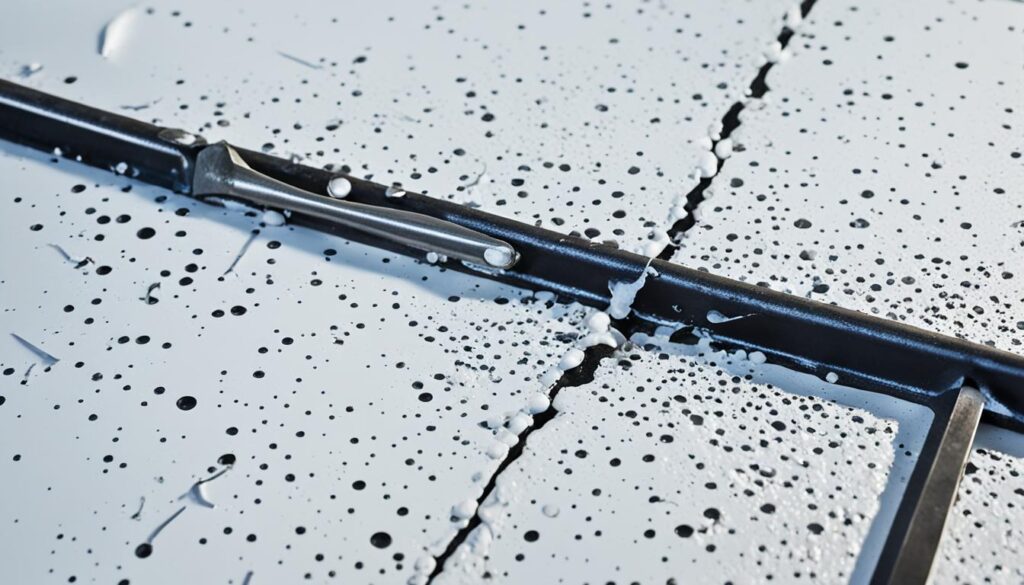
Using epoxy on wrought iron needs careful steps to succeed. Here’s how to do it right:
- Prepare the Surface: Start by cleaning off rust and dirt. A wire brush and rust remover help. This step is key for the epoxy to stick well.
- Mix the Epoxy: Follow the mixing instructions for the epoxy. It should be mixed well for the best bond.
- Apply the Epoxy: Put the mixed epoxy on with a spatula. Make sure it covers the damaged part completely.
- Clamp the Pieces: Use clamps to hold the repair together while the epoxy sets. It helps the pieces stick evenly and strongly.
- Allow for Curing Time: Wait for the epoxy to fully set, following the given time by the maker. This usually takes a few hours for a solid repair.
By carefully following these steps, you can fix wrought iron well with epoxy. This saves you money in the long term against costly repairs, which range from $300 to $1,5008. The right epoxy can protect your iron work for a very long time.
The combination of wrought iron’s strength with the correct epoxy helps keep your structures beautiful and strong5.
Alternative Methods for Wrought Iron Repair
When it comes to fixing wrought iron without welding, you have several good options. The top methods are using bolts and screws, and employing metal brackets. These ways let you repair wrought iron without welding, keeping things strong and steady.
Using Bolts and Screws
For a strong fix, bolts and screws are a great choice, especially for big repairs. You can secure things well and it’s usually not too difficult. Just make sure the bolts and screws you pick match the wrought iron. This stops issues from different metals reacting.
These materials are easy to get at hardware stores, making repairs affordable. But, check that the bolts and screws you use are tough enough for the job1. With the thumbs up from experts and lots of DIY fans, this method is a trusted one9.
Using Metal Brackets
Metal brackets are another solid way to fix wrought iron without welding. They ensure a stable connection and are very durable1. This approach works well for repairs that shouldn’t be welded, to avoid heat damage1.
You can find metal brackets in many sizes and shapes, offering flexibility for different repairs1. They can also be used with panel adhesive repair to make things stronger1. This way is much cheaper than hiring a welder or replacing the wrought iron with aluminum, saving you money9.
Choosing and using these alternatives carefuly helps you make a repair that lasts. It keeps your wrought iron looking good and working well, for years to come.
Preparing the Surface for Repair
Getting the surface ready for iron repair is key. It makes the fixes last longer and work better. It all starts with a good clean and getting rid of the rust.
Cleaning Wrought Iron
To clean wrought iron well, remove anything that might get in the way. A wire brush or sandblasting is good for this. They take off old paint, dirt, and grime. Don’t forget about the hard-to-reach spots. If the iron has old paint with lead, take it off safely to avoid breathing in lead dust10.
Rust Removal Techniques
Rust is a big problem in iron repair prep. Begin by sanding the rusty spots until you see the metal. You can also use rust converters to change rust into something that won’t spread. This helps the new paint or coating stick well. Then, wipe everything clean with a solvent. Keeping your iron maintained and well-prepared stops further damage.
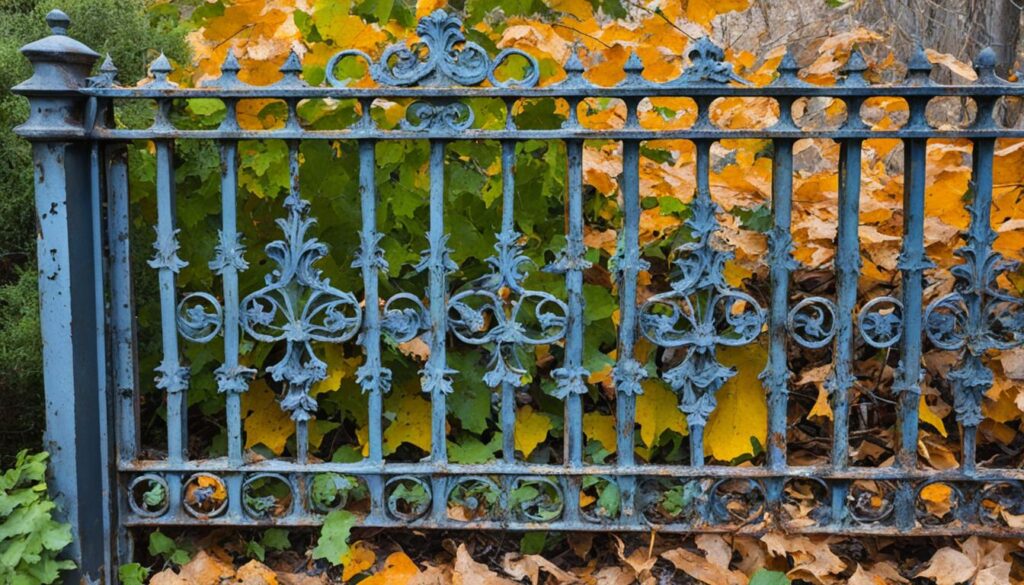
Securing the Wrought Iron Pieces
Securing iron pieces well is key in keeping your wrought iron repairs strong. After you prepare and apply adhesive, using clamps is vital. They help align the pieces correctly and keep them together strongly while the repair dries.
Using Clamps for Alignment
Using the right clamping techniques is critical for iron repairs. All sorts of tools, like Vise-Grips or special clamps, can be used. They keep the pieces still as the glue sets. It’s best to have a 1mm-2mm thick line of adhesive for the strongest bond11. Place these clamps carefully to prevent any movement as the adhesive hardens.
Ensuring a Strong Bond
A strong bond in repairs relies on good clamping. Clamps not only keep the pieces in the right place but also make sure the pressure is even. Using round steel posts with square tubing and steel epoxy can work well. This method, with proper clamping, is proven to be strong12.
Some repairs may need more, like mechanical fasteners for extra support11. This is especially true when the area for adhesive is too small on its own. For instance, fixing iron fencing can save money compared to replacing it entirely. Good clamping techniques are essential for long-lasting repairs.
Finishing Touches: Sanding, Priming, and Painting
When your repair is solid, it’s time for the final steps. Sanding, priming, and painting ensure a good-looking, safe finish.
Why Sanding is Important
Sanding is key for finishing wrought iron. It removes extra glue and readies the iron for primer. This step makes the primer stick well. Thus, it leads to a lasting finish.
It also gets rid of rust. This makes your iron’s surface smooth for painting.
Priming and Painting Tips
After sanding, a good primer layer is next. Aim for a low humidity under 80% for best results13. Let the primer completely dry for 24 hours13. Then, you can paint for a smooth, sturdy finish.
For painting itself, choose the best materials and ways. A fabricator in Huntington, WV recommends automotive epoxy paint for the best results14. When spray painting, stay 8 to 12 inches away. This helps paint evenly13. Use a barrier like a large piece of cardboard to stop overspray13.
It’s key to add a second paint coat within 1 hour of the first13. This ensures they stick well together and last. Some advice also says to pressure wash and use rust converters earlier for a great finish14.
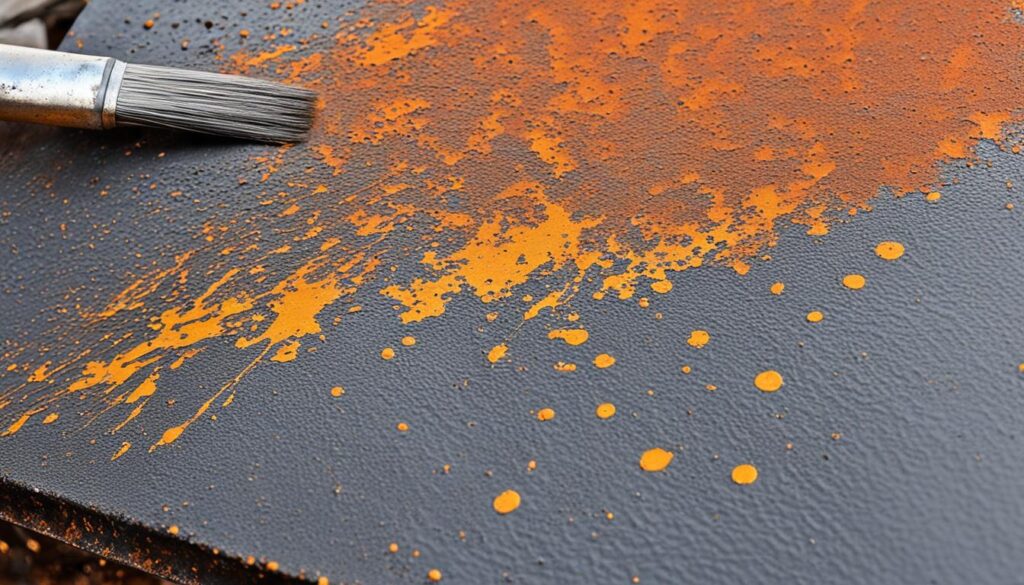
Getting a top-quality finish needs careful steps and application. Treat every part of the process carefully. Then, your wrought iron will not only look new but also be well-protected against rust and harm.
Maintaining Your Repaired Wrought Iron
To keep your ironwork looking great, you need to look after it well. Cleaning it regularly is very important. This stops dirt and rust from building up. When making repairs, start by cleaning and removing rust and old paint. Then, neutralize the rust. Finally, paint it with a primer that stops rust and condition the paint well15.
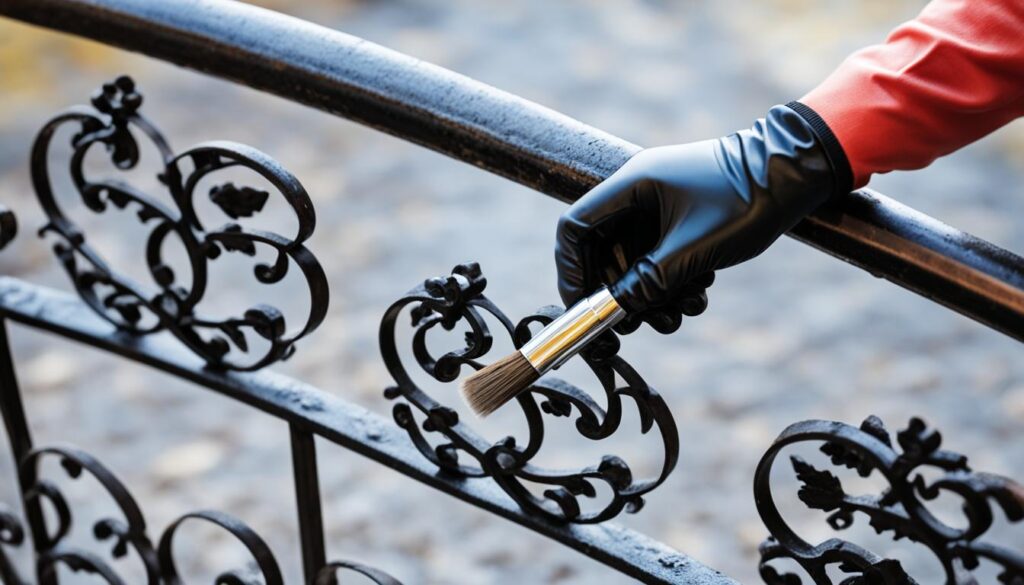
It’s crucial to check your ironwork often. Look for rust or damage, especially after bad weather. Fixing small problems early can prevent big, costly repairs. Even though wrought iron is strong, it can rust if not cared for right15.
Rust weakens iron fences by breaking them down over time15. So, it’s key to keep your iron dry and use protective coatings. Avoiding scratches is also important. Stick to a regular maintenance plan for the best results.
To keep your wrought iron in top shape, remember these tips:
- Always clean and dry the iron to keep moisture away.
- Check for damage often and fix any small rust spots right away.
- Use special primers and paints to fight off rust15.
- For areas that get wet a lot, use extra protection like galvanization or powder coating.
The method you use to repair your iron matters for its upkeep. Using a good adhesive instead of welding avoids warping. It makes a strong connection that can handle different weather conditions. The Evercoat adhesive we recommend takes 6-8 hours to cure, ensuring your repair will be solid the next day16.
Following these methods and staying on top of maintenance will extend the life of your ironwork. Keep an eye on it and act quickly to fix any problems. By being diligent and consistent, you can enjoy your iron creations for a long time.
| Maintenance Task | Frequency | Why It’s Important |
|---|---|---|
| Cleaning | Monthly | Prevents dirt and moisture accumulation. |
| Inspection for Rust | Bi-Monthly | Early detection of rust prevents structural damage. |
| Touch-Up Painting | Annually | Ensures continuous protection against corrosion. |
| Protective Coatings Application | As Needed | Provides an additional barrier against rust. |
Conclusion
Restoring wrought iron without welding might sound tough at first. But with the right knowledge and tools, it’s a project that anyone can tackle. We’ve looked at how to check the damage, get surfaces ready, and use different fixes. These are key parts of keeping ironwork alive that shines with information from the past.
Using epoxy, bolts, screws, or metal brackets all have their good points for iron restoration. More than just repair, this work is about valuing the skill and stories in each item. So, from cleaning to painting, every step is important for making your ironwork last and look great.
It’s key to be careful and slow when working on iron. And knowing that pre-heating for welding can be between 100°C and 400°C is useful17. This helps you make smart choices for fixing your pieces. Taking care of your wrought iron not only refreshes its look. It also keeps these historic pieces strong over time.
FAQ
How can I repair wrought iron without welding?
What makes wrought iron unique compared to other metals?
What are common issues that require wrought iron repair?
What steps should I follow for a visual inspection of wrought iron?
How effective are epoxies for wrought iron repair?
What are the steps for applying epoxy to wrought iron?
Are bolts and screws a good alternative for wrought iron repair?
How do I clean wrought iron before repairing it?
Why is clamping important in wrought iron repairs?
What is the importance of sanding, priming, and painting in wrought iron repairs?
How can I maintain my repaired wrought iron?
Source Links
- https://www.hagerty.com/media/maintenance-and-tech/no-weld-metal-repair/ – How to repair rusted metal without welding – Hagerty Media
- https://www.engineshed.scot/building-advice/building-materials/iron/ – View Engine Shed advice on iron
- https://www.sdcc.ie/en/services/planning/heritage-and-conservation/conservation-areas/iron-the-repair-of-wrought-cast-iron_.pdf – IRON THE REPAIR OF WROUGHT AND CAST IRONWORK
- https://www.dorothearestorations.com/consultancy-project-management/wrought-iron-maintenance-and-care-guide – Architectural Wrought Ironwork | Care & MaintenaArchitectural Wrought Iron
- https://bravofencecompany.com/wrought-iron-fence-repair-let-our-pros-help-you-out/ – Wrought Iron Fence Repair – Let Our Pros Help You Out
- https://www.eng-tips.com/viewthread.cfm?qid=11091 – Seeking a cast iron reparation method without welding – Mechanical engineering general discussion
- https://www.yeswelder.com/blogs/yeswelder/how-to-weld-cast-iron-and-avoid-weld-cracking – How To Weld Cast Iron And Avoid Weld Cracking
- https://vegasvalleyiron.com/repair-iron-fence/ – Different ways to repair iron fence, requirements, pros, and cons
- https://www.diychatroom.com/threads/repairing-wrought-iron-railing.669861/ – Repairing Wrought Iron Railing
- https://www.twi-global.com/technical-knowledge/faqs/faq-can-wrought-iron-be-repaired-by-welding – Can wrought iron be repaired by welding?
- https://www.forgeway.com/learning/blog/join-metal-to-metal-without-welding – No title found
- https://www.diychatroom.com/threads/wrought-iron-rail-repair.711425/ – Wrought iron rail repair
- https://www.truevalue.com/diy-projects/paint-and-stain/best-ways-to-paint-wrought-iron/ – Best Ways to Paint Wrought Iron
- https://www.finishing.com/241/01.shtml – Painting/repairing a rusty wrought iron fence
- https://www.bigeasyironworks.com/can-rusted-wrought-iron-be-repaired/ – Rusted Wrought Iron Repair | Big Easy Iron Works
- https://hagerty.com/media/maintenance-and-tech/no-weld-metal-repair/ – How to repair rusted metal without welding – Hagerty Media
- https://www.twi-global.com/technical-knowledge/faqs/can-you-weld-cast-iron – Can You Weld Cast Iron? (A Complete Guide)
